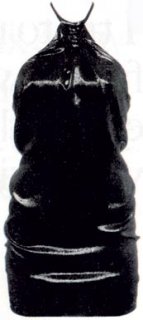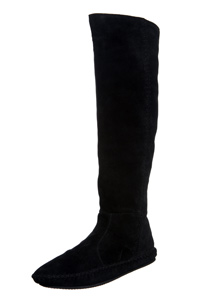images and story from timesonline.co.uk
The Kate divide
As New York sneers at Kate Moss’s range for Topshop, Lisa Armstrong explains that Americans don’t share our affection for shop-soiled glamour
After the hype, the backlash. New York magazine has declared Kate Moss’s collection for Topshop “bland”. The New York Post ’s headline — “Duplikate” — professed an equal frenzy of apathy. And spiky comments from Barney’s creative director, Simon Doonan, about Moss, Croydon and slags were gleefully taken out of context all over the press.
Moss does appear to have fallen for her own mythology recently, dangling precariously out of windows (oh, the danger!), playing Marianne to Mick Jagger (sort of) on an unconvincingly “spontaneous” loop of YouTube footage and flitting, eerily Yoko-like, in and out of Pete Doherty’s performances. But perhaps the lukewarm US media’s reaction versus the exitable British one says more about our nations’ different approaches to what might be called slightly soiled glamour. We love it, they don't. Stocking the range — which, lest we forget, is manufactured, priced and pitched at a high-street market — in Barney’s, one of New York’s slickest, most exclusive, department stores may be another factor. Anyway, here at The Times, we’ve seen it, and barring the odd chiffon smock and overly nylon mini we like it.
Does any of this matter to the famously flameproof Moss? Well, yes. There comes a time when even the most genetically blessed find combining hard living with close-up portraits an increasing grind. Kate Moss is no fool concerning her career. A gradual shift towards styling/design is not just the key to longevity and sanity, it represents a move into an area in which she has complete confidence. “I’ve never done this before,” she admits, “but I’ve seen it done for years.”
One of the most surprising aspects of the whole deal is how personal the collection is. For someone whose image is predicated as much on her sense of style as her physical attributes, Moss has been remarkably generous in sharing individual pieces from her own wardrobe. Then again, once she’s seen thousands of clones running around in facsimiles of her beloved waistcoats and hotpants, she may decide it’s time for some reinvention.
function pictureGalleryPopup(pubUrl,articleId) { var newWin = window.open(pubUrl+'template/2.0-0/element/pictureGalleryPopup.jsp?id='+articleId+'&&offset=0&§ionName=WomenFashion','mywindow','menubar=0,resizable=0,width=615,height=655'); }Sticklers may bridle at Moss coopting the word design for what she does (basically turn up at the Topshop offices every fortnight with carrier bags of her treasured clothes, try on all the samples and constantly suggest alterations). On the other hand, given that the angles of a lapel can make the difference between a jacket being sexy or staid, 2cm on the length of a dress can make it frumpy or fabulous and a well-placed dart can transform ordinary trousers into head-turning, buttock-raising, leg-lengtheners, Moss’s unerring eye for fit is no small thing. Of course there’s an argument to be made that buying into the Moss collection probably constitutes the most fundamentally unMoss like behaviour anyone could indulge in (though she’s not averse to borrowing from others’ style herself, whether it’s early Bardot or later Hendrix). Still, dismissing her collection on that basis alone would probably be an own goal. In a world where every other overstyled, freebie toting, visually clueless celebrity is held up as “style icon”, Moss’s instinctive eye and unfailing taste are the real deal. And, if nothing else, the modal-cotton-mix T-shirts and racer-back vests are great buys.
HOW MUCH WAS SHE INVOLVED?
Once Moss had inked the deal with Sir Philip Green in October, she was introduced to Topshop’s design consultant, managing director and head buyer, who were there to point out, inter alia, that a micro-mini that looked dandy on Moss at a Babyshambles gig may not work so well in a size 16.
— They were joined in fortnightly sessions by a technical fitter and a merchandise assistant, whose role was to work out how the collection would be displayed, packaged and branded. Moss turned up with a bag of her beloved vintage pieces (none with recognisable designer labels inside: Moss isn’t about to cannibalise the industry that has been so good to her). Various ideas were explored, sketched and sent to the manufacturers.
— When Moss returned, she tried on every sample, pulling in waists, rolling up sleeves, twisting reveres to achieve the recognisable Moss effect. “Two months in,” says Topshop design consultant Jaqui Markham, “we had rails and rails of clothes — ultimately we ended up using only 60 per cent — and still she kept on bringing in new items that had caught her eye, or she’d bike over a beaded camisole for us to have a look at for the limited collection pieces.”
— Items would be sent back to factories for alterations. Moss would return for more fittings and with more carrier bags: the process turned out to be mutually informative. “We learned a lot about what she likes and she learned how to put a whole collection together, from beachwear, to jeans, to vests, to how putting a pleat in a skirt can make it wearable to a much wider segment of women,” says head buyer Sophie Brierly. “The hardest thing was making great little bags that cost less than £200. Then again, her favourite Glastonbury bag was a little vintage one. Luckily she’s not hung up on price. She wears £200 jeans, but she’s also always worn Topshop’s £30 Baxters.” Prices in Moss’s collection range from £10 for vests to £150 for limited edition dresses.
The Kate divide
As New York sneers at Kate Moss’s range for Topshop, Lisa Armstrong explains that Americans don’t share our affection for shop-soiled glamour
After the hype, the backlash. New York magazine has declared Kate Moss’s collection for Topshop “bland”. The New York Post ’s headline — “Duplikate” — professed an equal frenzy of apathy. And spiky comments from Barney’s creative director, Simon Doonan, about Moss, Croydon and slags were gleefully taken out of context all over the press.
Moss does appear to have fallen for her own mythology recently, dangling precariously out of windows (oh, the danger!), playing Marianne to Mick Jagger (sort of) on an unconvincingly “spontaneous” loop of YouTube footage and flitting, eerily Yoko-like, in and out of Pete Doherty’s performances. But perhaps the lukewarm US media’s reaction versus the exitable British one says more about our nations’ different approaches to what might be called slightly soiled glamour. We love it, they don't. Stocking the range — which, lest we forget, is manufactured, priced and pitched at a high-street market — in Barney’s, one of New York’s slickest, most exclusive, department stores may be another factor. Anyway, here at The Times, we’ve seen it, and barring the odd chiffon smock and overly nylon mini we like it.
Does any of this matter to the famously flameproof Moss? Well, yes. There comes a time when even the most genetically blessed find combining hard living with close-up portraits an increasing grind. Kate Moss is no fool concerning her career. A gradual shift towards styling/design is not just the key to longevity and sanity, it represents a move into an area in which she has complete confidence. “I’ve never done this before,” she admits, “but I’ve seen it done for years.”
One of the most surprising aspects of the whole deal is how personal the collection is. For someone whose image is predicated as much on her sense of style as her physical attributes, Moss has been remarkably generous in sharing individual pieces from her own wardrobe. Then again, once she’s seen thousands of clones running around in facsimiles of her beloved waistcoats and hotpants, she may decide it’s time for some reinvention.
function pictureGalleryPopup(pubUrl,articleId) { var newWin = window.open(pubUrl+'template/2.0-0/element/pictureGalleryPopup.jsp?id='+articleId+'&&offset=0&§ionName=WomenFashion','mywindow','menubar=0,resizable=0,width=615,height=655'); }Sticklers may bridle at Moss coopting the word design for what she does (basically turn up at the Topshop offices every fortnight with carrier bags of her treasured clothes, try on all the samples and constantly suggest alterations). On the other hand, given that the angles of a lapel can make the difference between a jacket being sexy or staid, 2cm on the length of a dress can make it frumpy or fabulous and a well-placed dart can transform ordinary trousers into head-turning, buttock-raising, leg-lengtheners, Moss’s unerring eye for fit is no small thing. Of course there’s an argument to be made that buying into the Moss collection probably constitutes the most fundamentally unMoss like behaviour anyone could indulge in (though she’s not averse to borrowing from others’ style herself, whether it’s early Bardot or later Hendrix). Still, dismissing her collection on that basis alone would probably be an own goal. In a world where every other overstyled, freebie toting, visually clueless celebrity is held up as “style icon”, Moss’s instinctive eye and unfailing taste are the real deal. And, if nothing else, the modal-cotton-mix T-shirts and racer-back vests are great buys.
HOW MUCH WAS SHE INVOLVED?
Once Moss had inked the deal with Sir Philip Green in October, she was introduced to Topshop’s design consultant, managing director and head buyer, who were there to point out, inter alia, that a micro-mini that looked dandy on Moss at a Babyshambles gig may not work so well in a size 16.
— They were joined in fortnightly sessions by a technical fitter and a merchandise assistant, whose role was to work out how the collection would be displayed, packaged and branded. Moss turned up with a bag of her beloved vintage pieces (none with recognisable designer labels inside: Moss isn’t about to cannibalise the industry that has been so good to her). Various ideas were explored, sketched and sent to the manufacturers.
— When Moss returned, she tried on every sample, pulling in waists, rolling up sleeves, twisting reveres to achieve the recognisable Moss effect. “Two months in,” says Topshop design consultant Jaqui Markham, “we had rails and rails of clothes — ultimately we ended up using only 60 per cent — and still she kept on bringing in new items that had caught her eye, or she’d bike over a beaded camisole for us to have a look at for the limited collection pieces.”
— Items would be sent back to factories for alterations. Moss would return for more fittings and with more carrier bags: the process turned out to be mutually informative. “We learned a lot about what she likes and she learned how to put a whole collection together, from beachwear, to jeans, to vests, to how putting a pleat in a skirt can make it wearable to a much wider segment of women,” says head buyer Sophie Brierly. “The hardest thing was making great little bags that cost less than £200. Then again, her favourite Glastonbury bag was a little vintage one. Luckily she’s not hung up on price. She wears £200 jeans, but she’s also always worn Topshop’s £30 Baxters.” Prices in Moss’s collection range from £10 for vests to £150 for limited edition dresses.




















 shame my similar signed school shirts are covered with 11 year old's messy handwritting -I should have asked my classmates to write more neatly. darn!
shame my similar signed school shirts are covered with 11 year old's messy handwritting -I should have asked my classmates to write more neatly. darn!




